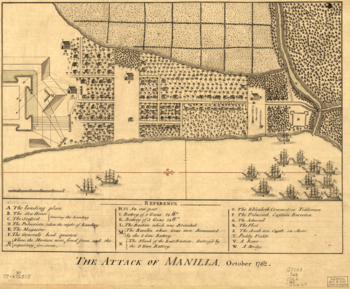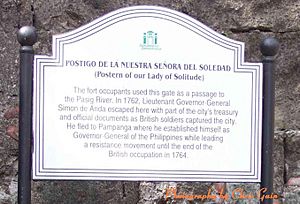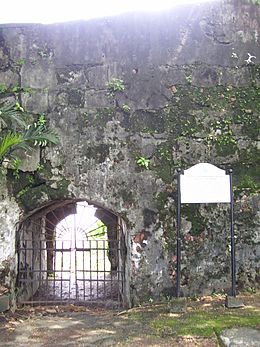British occupation of Manila facts for kids
Quick facts for kids
British occupation of Manila
|
|||||||||
|---|---|---|---|---|---|---|---|---|---|
| 1762–1764 | |||||||||
|
Flag
|
|||||||||

"The Attack of Manilla, October 1762", depicting the British capture of Manila
|
|||||||||
| Status | Occupation of Manila by the Kingdom of Great Britain |
||||||||
| Capital | Manila, Bacolor, Pampanga (Spanish Philippine colonial government retains control outside of Manila and Cavite) |
||||||||
| Common languages | Spanish and Tagalog | ||||||||
| Religion | Roman Catholicism | ||||||||
| Monarch | |||||||||
|
• 1760–1820
|
George III | ||||||||
| Governor-General | |||||||||
|
• 1762–1764
|
Dawsonne Drake | ||||||||
| Historical era | Spanish colonial rule | ||||||||
| 6 October 1762 | |||||||||
| 31 May 1764 | |||||||||
| Currency | Spanish dollar | ||||||||
|
|||||||||
The British occupation of Manila happened during the colonial history of the Philippines. The Kingdom of Great Britain took control of Manila, the Spanish capital, and the nearby port of Cavite. This lasted for 20 months, from 1762 to 1764. This event was part of a bigger conflict called the Seven Years' War, where Britain was fighting against France. Spain had recently joined the war on France's side.
Britain wanted to use Manila as a major trading hub in Asia, especially for trade with China. After capturing the city, the British demanded a large payment from the Spanish to stop further looting. However, a Spanish leader named Lieutenant Governor Simón de Anda y Salazar quickly set up a new government. With the help of Filipino soldiers, he stopped the British from taking control beyond Manila and Cavite.
Contents
Why the British Came to Manila
At this time, Britain and France were fighting in the Seven Years' War. As the war went on, Spain, which had been neutral, worried that Britain's many wins against France would threaten Spanish interests. France then convinced Spain to sign a secret agreement called the Family Compact in August 1761. This agreement meant Spain would prepare for war against Britain.
Britain declared war on Spain in January 1762. Spain declared war on Britain soon after.
Britain's Plan for Manila
In January 1762, the British government decided to attack Havana in the West Indies. They also approved a plan by Colonel William Draper to capture Manila. Draper was a commander in British India. King George III of Great Britain agreed to this plan. He believed that taking Manila would help Britain expand its trade after the war.
Manila was one of the most important trading cities in Asia. The East India Company, a powerful British trading company, wanted to increase its influence there. They hoped capturing Manila would severely hurt Spain's trade.
Draper was promoted to brigadier general. The East India Company chose Dawsonne Drake to be the civil governor of the islands.
British Capture of Manila
On September 24, 1762, a British fleet arrived in Manila Bay. It included eight large warships, three smaller ships, and four supply ships. There were 6,839 soldiers and sailors. This force, led by William Draper and Samuel Cornish, captured Manila. Manila was known as the "greatest Spanish fortress in the western Pacific."
The Spanish lost Manila partly because the city was not ready for a military attack. Also, their military leadership was poor. The previous Spanish governor had died, and his replacement had not yet arrived. So, the Archbishop of Manila, Manuel Rojo del Río y Vieyra, who had no military experience, was temporarily in charge. This led to many mistakes by the city's defenders.
On October 5, 1762, the night before the walled city of Manila fell, the Spanish military urged Archbishop Rojo to surrender. The British had heavily attacked the city walls. They had broken through the San Diego fort and destroyed its cannons. They also set parts of the town on fire. Early on October 6, British forces attacked and easily took the fortifications.
During the attack, the Spanish lost many soldiers. About 300 Filipino troops were killed and 400 were wounded. The British had 147 killed or wounded. The British ships fired over 20,000 cannonballs during the attack.
The Occupation Begins
After Manila was captured, the British soldiers began to loot the city. Archbishop Rojo wrote that the looting lasted for more than 30 hours. He blamed both the Spanish, Chinese, and Filipino residents, as well as the British soldiers. Rojo described how the city was completely looted, including churches and even parts of the palace.
The British general, Draper, tried to stop the looting, but it continued. Governor Dawsonne Drake then demanded a ransom from the Spanish. He asked for four million Spanish dollars to stop his troops from further looting. Rojo agreed to pay this amount. However, by the time the British left, only a quarter of the ransom had been paid.
On November 2, 1762, Dawsonne Drake became the Governor of Manila. He was an official from the East India Company. Drake was helped by a council of four men. When Drake realized he wasn't getting as much money as he expected, he set up a special court. He imprisoned several people from Manila on charges that were not clear. Captain Thomas Backhouse called this court unfair.
The British also gained more wealth by capturing Spanish treasure ships. They took the Filipina, which carried American silver. They also captured the Santísima Trinidad in a battle near Cavite. This ship carried a valuable cargo of Chinese porcelain. The cargo of the Trinidad alone was worth $1.5 million, and the ship itself was worth $3 million.
Spanish Resistance

Meanwhile, the Royal Audience of Manila, a high Spanish court, organized a plan to resist the British. They sent a judge named Don Simón de Anda y Salazar to the town of Bulacan. His mission was to organize continued resistance. The Royal Audience also made Anda the Lieutenant Governor. That night, Anda took a large part of the treasury and official records. He escaped from Fort Santiago through a small back gate, got on a boat on the Pasig River, and went to Bulacan.
He later moved his headquarters to Bacolor, Pampanga, which was safer. He quickly got strong support from the Augustinians, a religious order. On October 8, 1762, Anda wrote to Archbishop Rojo. He told Rojo that he was now the Governor and Captain-General. He explained that Spanish law allowed power to shift to the Royal Audience if there was an invasion. Anda, being the highest member of the Audience not under British control, took all powers. Rojo refused to recognize Anda as Governor-General.
The surrender agreement between Archbishop Rojo and the British promised to protect the Roman Catholic religion and private property. It also allowed citizens to travel and trade peacefully as British subjects. Under British rule, the Philippines would still be governed by the Royal Audience, with Spain paying the costs.
Anda refused to accept any agreements signed by Rojo. He said Rojo was forced to sign them, making them invalid under Spanish law. He also refused to talk with the British unless they addressed him as the true Governor-General. King Charles III of Spain later approved all of Anda's actions.
Anda eventually gathered an army of over 10,000 fighters, mostly Filipino volunteers. Even though they didn't have many guns, they managed to keep the British mostly stuck in Manila and Cavite.
In November, British Captain Backhouse scattered Anda's troops from Pasig. He then set up a post there to control Laguna de Bay. In January, the British sent an expedition against Bulacan. They were helped by 400 Chinese civilians after Anda had ordered some Chinese to be executed for helping the British. The British took Malolos on January 22 but failed to reach Anda in Pampanga. They left Bulacan in February. In the spring of 1763, Backhouse tried another attack against Anda, going as far as Batangas.
The main British fleet left in early 1763. On July 24, news arrived that the fighting had stopped. On August 26, a first draft of the Peace of Paris was signed. This treaty said that any lands captured that were not known about at the time of signing would be returned to their original owners. The situation in Manila remained difficult because the British order to withdraw would not arrive for another six months. Anda continued his blockade of the city.
The Final Months
The Seven Years' War officially ended with the signing of the Treaty of Paris on February 10, 1763. When the treaty was signed, no one knew that Manila had been captured by the British. Because of this, Manila was included in the general rule that all other captured lands would be returned to Spain.
After Archbishop Rojo died in January 1764, the British military finally recognized Simón de Anda y Salazar as the rightful Governor of the Philippines. They sent him a letter addressed to the "Real Audiencia Gobernadora y Capitanía General." After this, Anda agreed to a truce, saying the British forces must leave Manila by March.
The British finally received their orders to withdraw in early March. By mid-March, the new Spanish governor for the Philippines, Brigadier Don Francisco de la Torre, arrived. This governor brought orders from London for the British to hand over Manila to him. Drake left Manila on March 29, 1764. The British officially ended their occupation and left Manila and Cavite in the first week of April 1764.
What Happened Next
Diego Silang, a Filipino leader, was encouraged by Spain's weakness. The British had promised him military help if he started a revolt against the Spanish in the Ilocos Region. However, this help never came. Silang was later killed by his own friends. His wife, Gabriela Silang, took over the leadership, but she was captured and executed by the Spanish.
Sultan Azim ud-Din I of Sulu had signed an alliance treaty with the British. He was taken with the British forces when they left Manila. The British hoped he could help their trading company in the Sultanate of Sulu. As the British forces faced more problems, some Indian soldiers left their posts. They settled in places like Pasig, Taytay, and Cainta.
The argument over Spain paying the rest of the ransom, and Britain paying for the damage caused by Drake in Manila, continued in Europe for many years. The capture of the Spanish treasure ships Santissima Trinidad and Filipina made the occupation profitable for the British government. This was a big loss for Spain.
However, the British could not control areas beyond Manila and Cavite. This made their occupation unsustainable. Captain Backhouse reported to London that "the enemy [Spanish] are in full possession of the country."
The British had accepted the surrender of the Philippines from Archbishop Rojo. But the Royal Audience of Manila had already named Simón de Anda y Salazar as the new Governor-General. This was allowed under Spanish law, and King Charles III of Spain later confirmed it. It was not the first time the Royal Audience had taken charge of defending the Philippines when there was no higher authority.
As Francisco Leandro Viana, who was in Manila during the occupation, explained in 1765, "the English conquest of the Philippines was just an imagined one, as the English never owned any land beyond the range of the cannons in Manila."
The old Spanish maps that Alexander Dalrymple took from Manila gave the British new information about the Pacific Ocean. This encouraged them to search for an unknown southern land.
Images for kids
See also
 In Spanish: Ocupación británica de Manila para niños
In Spanish: Ocupación británica de Manila para niños






